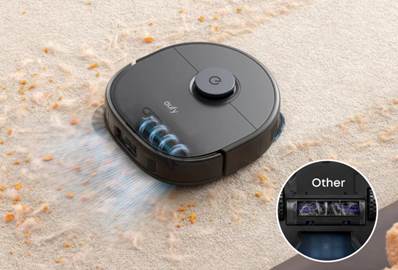Can Robot Vacuums Reduce Allergy Triggers?
Allergens like dust mites and pollen can make homes uncomfortable for sensitive individuals. Robot vacuums offer a modern solution to this problem by incorporating advanced technologies that help reduce allergen levels. These smart devices streamline the cleaning process, making it easier to maintain a healthy living environment. Equipped with state-of-the-art features tailored for allergen control, best robot vacuum promises not only cleanliness but also improved indoor air quality. As households increasingly invest in these automated cleaners, it’s essential to understand how they contribute to a healthier home atmosphere. This article explores the various ways robot vacuums tackle allergens and highlights the efficient mechanisms they employ.

How Robot Vacuums Reduce Allergens
Filtration
Systems Trap Allergens
Filtration
systems in robot vacuums are designed to capture tiny particles circulating in
the household. High-Efficiency Particulate Air (HEPA) filters are commonly
implemented in these devices to trap allergens such as pollen, pet dander, and
dust mites effectively. HEPA filters capture particles as small as 0.3 microns,
ensuring that allergens do not escape back into the air. By ensuring that
captured particles remain trapped, these vacuums serve as a reliable ally in
maintaining a clean environment. Users often notice a significant reduction in
allergy symptoms after incorporating a robot vacuum with an advanced filtration
system.
Strong
Suction Helps Pick Up More Dirt
Modern
robot vacuums boast strong suction capabilities that enhance their cleaning
efficiency. This feature is crucial for removing dust and debris from floors,
carpets, and rugs. When combined with rotating brushes, robot vacuums can
dislodge and then suction more dirt and dust particles from surfaces. This
thorough cleaning method ensures that even deeply embedded dust, which often
triggers allergic reactions, is effectively removed. As a result, robot vacuums
make it possible to reduce allergen levels, creating a cleaner and healthier
home for all.
Mopping
Function Further Improves Indoor Air Quality
Many
robot vacuums come equipped with a mopping function that adds an extra layer of
cleanliness. By tackling fine dust and tiny particles that vacuuming alone
might miss, the mopping function enhances a vacuum’s ability to reduce
allergens. It works by using water or specialized cleaning solutions to wipe
down hard surfaces after vacuuming. This feature reduces airborne dust
particles, leading to improved indoor air quality. By employing both vacuuming
and mopping, these robots create a cleaner and fresher living space, beneficial
for individuals sensitive to allergens.
Robot
Vacuums Can Target Hard-to-Reach Areas
These
agile devices excel at cleaning under furniture and other challenging areas
often missed by traditional vacuums. Robot vacuums feature a slim design and
sensors that enable them to navigate beneath beds, sofas, and other tight
spaces. These zones often accumulate dust and allergens, contributing to indoor
air pollution. By routinely cleaning these nooks and crannies, robot vacuums
significantly diminish potential allergens. Their ability to access these areas
ensures comprehensive cleaning, making them a valuable tool in maintaining a
dust-free home environment.
Regular
and Scheduled Cleaning Reduces Allergen Build-Up
The
convenience of setting regular cleaning schedules ensures that robot vacuums
keep homes consistently clean. Scheduled cleanings mean these devices can
operate several times a week or even daily, continually reducing the build-up
of allergenic particles. This frequency prevents allergens from accumulating,
maintaining a healthier living environment over time. The hands-free operation
provides homeowners the peace of mind that their cleaning routine is active,
fostering ongoing reduction in dust and allergens.
Benefits Summary of Allergy Reduction
Robot
vacuums offer a powerful, low-effort solution for minimizing allergens in the
home. Featuring HEPA-grade filters that lock in fine particles like pollen, pet
dander, and dust mites, they ensure cleaner air output. Their robust
suction—especially when paired with rotating brushes—draws out deeply embedded
dust in carpets and floors. Many models also include mopping functions to wipe
away remaining residue. With slender, sensor-guided designs, they venture under
furniture where allergens accumulate. Plus, scheduled cleanings maintain
continuous upkeep. Together, these features make robot vacuums an effective
ally in reducing indoor allergy triggers.

How
Do Eufy Robot Vacuums Help Reduce Allergens?
Eufy
robot vacuums combine top-notch features to enhance allergen reduction. They
come equipped with HEPA-style filters designed to trap up to 99% of microscopic
particles, ensuring fewer airborne allergens. Strong suction and smart
navigation are standard in Eufy models, allowing for effective dirt and debris
removal across various surfaces. The BoostIQ™ technology in some models
increases suction power when needed, ensuring deep cleanings on carpets and
rugs. Additionally, Eufy vacuums can be programmed for scheduled cleanings,
giving families reliable relief from allergens. With a sleek design, these
vacuums easily reach under furniture, targeting hidden dust pockets. Overall,
Eufy provides an efficient, user-friendly option in the fight against household
allergens.
Conclusion
Robot
vacuums are an effective tool in minimizing allergen presence in households.
Through advanced filtration systems, strong suction, mopping capabilities, and
smart designs, they efficiently clean environments, making them healthier for
individuals with allergies. Frequent and scheduled cleaning helps keep allergen
levels low, offering lasting benefits. Brands like Eufy exemplify how
technology can be harnessed to improve air quality and reduce
allergy-triggering substances. By investing in a robot vacuum, households can
create a more comfortable, allergen-reduced space, allowing everyone to breathe
easier and live healthier.


